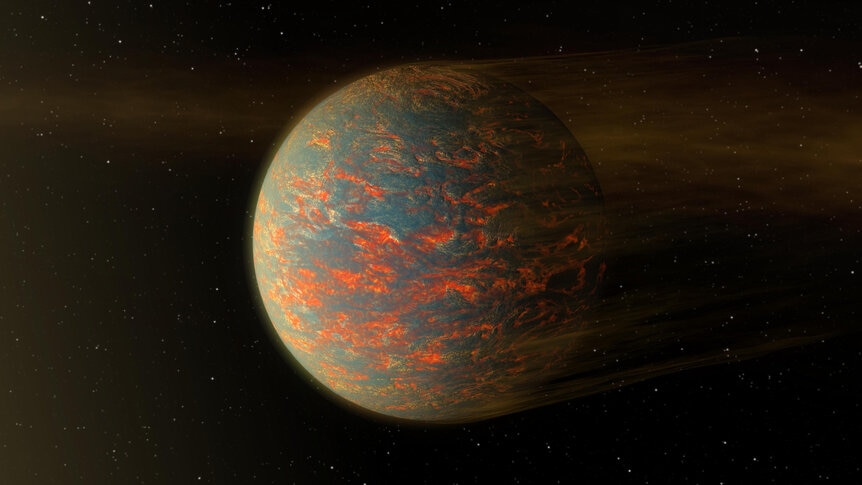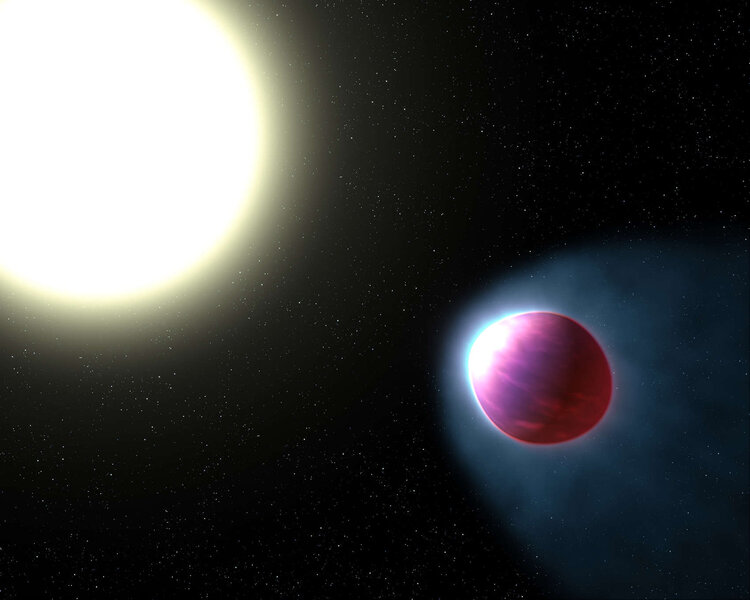Create a free profile to get unlimited access to exclusive videos, sweepstakes, and more!
Astronomers find a torched super-Earth on a ONE DAY orbit around its star
We’ve found the last planet in the galaxy you'd want to live on.

Astronomers have discovered a rare exoplanetary beast, and it’s providing evidence that planetary formation and evolution over time take a lot of different pathways. It’s a super-Earth getting positively cooked by its host star, but the baffling part is its big sibling right next door [link to paper].
The star is called WASP-132. It’s about 400 light-years from us, and is slightly smaller, cooler, and lower mass than the Sun. The newly discovered planet, called WASP-132 c, was found using observations by the Transiting Exoplanet Survey Satellite, or TESS, which scans the skies looking at relatively nearby stars. If we happen to see a planet’s orbit edge-on then it will pass in front of its star once per orbit, causing it to dim somewhat on a regular period. This event is called a transit, and is still the most successful method in finding exoplanets: alien worlds orbiting other stars.
RELATED: A nearby super-Earth may be a water world
WASP-132 c is bigger than Earth, but not too much so: It’s about 1.85 times Earth’s diameter, so we call it a super-Earth. We don’t know much else about the planet itself except that its mass must be less than about 37 times the mass of Earth, which doesn’t constrain things much.
We do know more about its orbit, and this is where things heat up, literally. The planet orbits the star in almost exactly one Earth-day! In other words, its year is one of our days. That means it’s extremely close to the star — skimming just a little over 2 million kilometers from its surface. That’s only five times the Moon’s distance form Earth, so that planet is dancing close to the flame.
It’s also extremely hot. Given the temperature of the star and making some decent assumptions about the planet’s reflectivity, it has a temperature of roughly 1,150°C (over 2,000°F). That’s not quite hot enough to melt iron, but far more than enough to melt rock. If the planet has a surface, it may be covered in lava. The star would be a staggering 40° across in the sky, stretching halfway from the horizon to the zenith. The planet receives about 870 times as much light and heat from its star as Earth does from the Sun, so this is not exactly a great place to visit.
All of this is amazing, but not all that unusual: Dozens of exoplanets are known with even shorter periods, and some are even hotter. WASP-132 c isn’t close to breaking any records.
What is so unusual about this planet is that it’s the second planet found around WASP-132. The first, called WASP-132 b, is a hot Jupiter, a gas giant orbiting very close to its host star, and that’s strange indeed. While we know of 500 such sizzling jovians — roughly 10% of all known exoplanets — only three previously have been found to have a second planet in an orbit close to the hot Jupiter.
WASP-132 b and c are the fourth such system found, and how they form is a mystery.
The very first exoplanets found orbiting stars like the Sun were hot Jupiters; the planets are big, so they cause a big dip in the star’s light, and they orbit quickly, making transits often enough that they’re easy to spot. Still, they were a huge surprise; we have nothing like that in our solar system — Jupiter is five times as far from the Sun than Earth — and it wasn’t clear how they form.
They couldn’t form that close to the star! Planets form from a disk of material swirling around a young star, and close in that stuff is far too hot to create a big planet. The going idea now is that they form much farther out, and then get too close to another gas giant planet. They interact gravitationally, sending one planet on a long elliptical orbit that brings it very close to the star. Over time the star’s tides circularize the orbit, leaving behind the hot Jupiter.
But in that case any other planets close to the star will get seriously destabilized by the bigger planet swinging around. They either get ejected from the system or dropped into the star. Either way, bye-bye.
So how can there be hot Jupiters out there with another planet orbiting close by?
A clue might be found in warm Jupiters. These are gas giants orbiting not quite as close in, so they aren’t as extreme. Importantly, these commonly have other planets nearby, so they must have formed in a different way. The thinking is that all the planets slowly move toward the star over time. This migration would mostly happen early on in the system’s history, when there was still a lot of material in a disk around the star. The disk can steal orbital energy from the planets, dropping them all toward the star. Eventually the disk dissipates, leaving the gas giant and other planets moderately close to their host star.
Looking at it that way, the four hot Jupiters with close-by planets may just be the tail end of the distribution of warm Jupiters, ones that got closer to the star than usual before the disk went away. This would be a relatively rare event, which is why we see so few.
On the other hand, finding a planet near a hot Jupiter is observationally difficult. So there may be a lot more out there we simply haven’t found yet.
We probably won’t know more until we find more… or don’t find more. TESS is still looking, as is ESA’s CHEOPS mission, so in the coming few years we’ll probably know a lot more about these worlds.
One thing is for sure: The more exoplanets we find, the more we see our own solar system is weird. We’re not like the vast majority of other planetary systems, and it would be very interesting indeed to find out why.





























